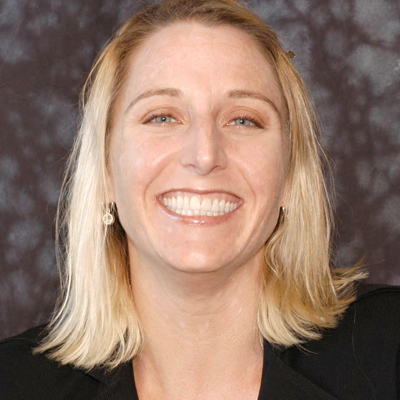Mathematics pairs with biochemistry to speed the process of drug design
Dr. Julie Mitchell, of the University of Wisconsin, Madison, is interested in the interface of biophysics and data science. By predicting the effects of amino acid mutations on protein binding, she and her team can highlight the amino acids that make the strongest contributions to bindings and therefore the best targets for drug design. This knowledge is used toward protein engineering based on naturally occurring molecules or to pinpoint regions in protein-protein interfaces that can be targeted with small drug molecules. More recently, she has combined her work with data on molecular evolution, gaining a deeper understanding of the underlying physics that allows the molecules to recognize one another. Through the development of Dr. Mitchell’s predictive models and her strategies to utilize genomic data collected for other organisms within her prediction, she and her team are crafting the computational tools necessary for tomorrow’s therapeutics.
As an avid collaborator, in the last year alone, Dr. Mitchell saw three important collaborations with experimental groups in which her computational tools helped to advance science towards translational applications. For instance, with a group from Oxford, she and her team helped assemble an immune signaling interaction that is implicated in autoimmune disorders. Such interdisciplinary and collaborative work has had a lasting impact on the scientific community. In fact, Dr. Mitchell’s group was one of the very first to apply bioinformatic techniques toward questions in biophysics, an area that has recently exploded due to its success. Future research is directed toward the use of evolutionary data toward the improved understanding of the physics underlying molecular interactions. this knowledge can be utilized to build better algorithms for predicting binding strength and specificity. Specificity is an especially difficult question, and many people may remember problems caused by Vioxx, which unfortunately bound to a second molecule that was not the intended target of the drug. In fact, a lack of specificity is the source of many adverse drug side effects.
Current research includes:
-
Biomolecules: Dr. Mitchell is at the forefront of applying data science in the context of biomolecules. Her research continues to lead the field in advancing molecular biophysics. In the future, she and her team hope to learn more about the physics of molecules by integrating data science and molecular evolution, and in ways that aid the design of future therapeutics.
-
Predictive Models: Dr. Mitchell and her team are on the cutting edge of how people model molecules and furthermore, how to harness computing technology at a large scale. By combining cutting-edge computing technology and molecular modeling, her predictive models offer incredible accuracy and consistency.

Bio
Dr. Julie Mitchell’s interest in mathematics and the sciences started as a young child; in fact, her first memory of mathematics when at eight years old she was advanced a grade level in mathematics due to her outstanding performance. She describes the way in which STEM courses built her self-esteem as a child explaining that, while she was not always “the student who had the top score on exams,” she was “ahead of classmates at anticipating new concepts before the teacher presented them.”
When it came time to declare an undergraduate major, Dr. Mitchell had originally selected an unrelated major. After one class that she found less than enthralling, she quickly narrowed the decision to a choice between math and chemistry, eventually settling upon math. Dr. Mitchell remembers moments in which she even stunned college level professors. For instance, once in a physics class, she was able to solve a problem that a professor had given for ten years that no one had been able to solve. She laughs recalling the image of herself, a blond twenty-something girl in a mini skirt, when she raised her hand and confidently told the professor she knew how to solve it. His eyes lit up when she explained how to finish a problem that he himself did not know how to solve completely.
Dr. Mitchell’s first independent project was to write a computer program to compute and display fractal images. Working before the Internet meant that she even had to track down a graphics programming manual for Macintosh that dated back to 1990. Her incredible dedication and persistence paid off because for nearly a decade, her codes ran, even through System 7 and beyond. She is an ace programmer and still enjoys writing new codes in several languages, including C++ and Python.
Her once challenging choice between math and chemistry as an undergraduate major has since come full circle in her current position as a Professor of Mathematics and Biochemistry. Earning a Ph.D. in Mathematics at the University of California, Berkeley in geometric analysis, she still wanted to make math less abstract and more tangible. It was her hope to connect her research and the real world that led her to a conversation with a chemist about the ways a mathematician might become involved in chemistry-related research. After the chemist pointed Dr. Mitchell toward protein structure as an area of interest, she never looked back. In fact, her postdoctoral training at the San Diego Supercomputer Center was an incredible opportunity in which the areas of bioinformatics, high-performance computing and mathematical biology expanded while she was in the center of the change.
Drawn to her current position as a faculty member at the University of Wisconsin-Madison due to the dual nature of her appointment, Dr. Mitchell has continued to integrate her passion for relatable application and empirical science. This connection could not be made more clear than the moment she was asked by the hiring committee why she would want to split her time with a joint appointment in two such seemingly disparate departments. She responded, “It is the biggest challenge I can imagine to integrate myself into a more traditional science department and ensure that the work I do is directly relevant to science.” If the evidence of her past success or her future innovations are a measure, she has largely lived up to such a challenge.
In her free time, aside from research, Dr. Mitchell enjoys spending time at the local art museum where she once volunteered as a docent. If you were to visit her home you would find an impressive collection of museum books from around the world. Despite the presence of the museum books, a guest in Dr. Mitchell’s home may be more likely to notice the two jukeboxes. Her 1973 Wurlitzer 1050 was the last American-made jukebox of the iconic brand, but it’s the 1953 Seeburg M100B that is her favorite, as it was the first model to play 45 records and has a tube amp that makes rock n' roll sound like an audiophile’s dream.
Website: http://mitchell-lab.org


